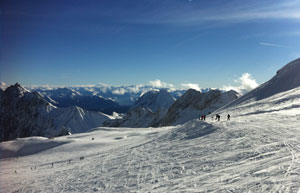Garmisch lacks a vast ski area on the resort’s doorstep. Instead, half a dozen small, fragmented areas have been grouped together via the delightfully named Happy Ski Pass.
Think of the Alps, and the image that immediately leaps to mind is Switzerland’s iconic Matterhorn, or majestic Mont Blanc astride the Franco-Italian border. If asked to name an Alpine resort, Kitzbühel, St. Moritz, Chamonix, and Cortina fall easily off the tip of the tongue. But odds are that a German ski resort wouldn’t crack most top 10 lists — maybe not even the top 25 or 50.
And that’s odd, really, when you think about it. Germany has more than 500 ski areas (albeit not all in the Alps, which run along its southern border), and for many decades it was also the part of Europe where more Americans skied than any other, thanks to the post-World War II U.S. military bases situated throughout the country. Even some 60-odd years after the end of the war, there’s no shortage of U.S.-owned and -operated resorts here, along with plenty of instructors trained by the Professional Ski Instructors of America. So why doesn’t a place like Garmisch-Partenkirchen get the worldwide recognition it deserves?
 A big reason may be its sizeable domestic market: With so many locals taking to the slopes, there’s little impetus to expend valuable resources attracting an international clientele. Another, perhaps more crucial, reason is that — unlike the Rockies resorts many Americans favor — Garmisch lacks a vast ski area on the resort’s doorstep. Instead, half a dozen small, fragmented areas have been grouped together via the delightfully named Happy Ski Pass.
A big reason may be its sizeable domestic market: With so many locals taking to the slopes, there’s little impetus to expend valuable resources attracting an international clientele. Another, perhaps more crucial, reason is that — unlike the Rockies resorts many Americans favor — Garmisch lacks a vast ski area on the resort’s doorstep. Instead, half a dozen small, fragmented areas have been grouped together via the delightfully named Happy Ski Pass.
This shouldn’t be a deterrent — there’s truth behind the cliché that good things come in small packages. What Garmisch loses in acreage it gains in spectacle: Standing atop the 9,717-foot Zugspitze after the long trundle up from town, looking down at the ski runs in the valley that holds Germany’s only glacier, you can’t help but be awed by the view. And though said runs are limited, there are challenges to be had off-piste in the marked safe area (guides are available, and advised) and at the famed Kandahar run in the nearby Garmisch-Classic sector. With a staggering 92 percent incline — the steepest in ski racing — on its aptly named Freier Fall (the fancy German way of saying “free fall.”) section, the run is popularly regarded as one of the most intimidating on the World Cup circuit. The Kandahar was in the competitive skiing’s spotlight once again when Garmisch-Partenkirchen hosted the 2011 Alpine World Ski Championship.
While the ski areas may be small, Garmisch-Partenkirchen itself is pretty big. As the name suggests, Garmisch and Partenkirchen were individual towns before they were (unwillingly) merged for the 1936 Olympics. Garmisch dates to medieval times and is the larger of the two; smaller Partenkirchen was founded during the Roman era. Despite their distinct histories and personalities, they have come together to create the quintessential German resort town, down to the picture-postcard Bavarian buildings adorned with colorful luftmalerei (these “air paintings” represent Bavaria’s take on the trompe l’oeil (deceive the eye) painting technique that was all the rage in 18th-century Europe) frescoes and the charming cog railway, the Zugspitzbahn, that offers a scenic 75-minute journey up the mountain.
Beyond the slopes, there is plenty to occupy visitors, from shopping on the Ludwigstrasse in the heart of Partenkirchen to visiting the ruins of the 13th-century Werdenfels Castle to dining on traditional Bavarian meals accompanied by hearty German beer.
Lodgings here are plentiful and comfortable, whether you’re seeking a spot in the heart of the action or a place to get away from it all. In the center of Garmisch you’ll find the Atlas Posthotel, built on the foundation of a tavern established in 1512. The aptly named Grand Hotel Sonnenbichl, on the outskirts of town, combines a convenient location with a pastoral ambience.
For a truly special getaway, head some 10 miles southeast to the newly renovated Schloss Elmau, a five-star retreat set in an idyllic alpine meadow. Originally built in 1912, the property saw service as a training center for the U.S. Army just after the war, and then as a sanatorium for Holocaust survivors shortly after that. In 2005 the hotel was devastated by an electrical fire, but the phoenix that has arisen from the ashes beautifully harmonizes the area’s natural beauty with the best in luxury lodging: opulent appointments, two state-of-the-art spas, and a Michelin-starred restaurant.
With such diversions, motivating yourself to get on the hill might be as big a challenge as getting down it, but don’t let that stop you. Garmisch-Partenkirchen’s slopes may be off the radar, but they deserve a place on any skier’s short list.
SNOW Tidbits:
*Garmisch-Partenkirchen Tourist Office, +49 (0) 8821 180 700; gapa.de
Best Of The Alps, +41 (0) 79 433 68 21; bestofthealps.com
Zugspitze Ski Area, +49 (0) 8821 7970; zugspitze.de
*2011 marked the first time since 1978 — after five unsuccessful bids — that Germany won the honor of hosting the Championship. This despite the fact that Garmisch-Partenkirchen is a member of the elite club of resorts worldwide that can boast of having hosted events for the Olympics, World Cup, and World Championship.
*Hotels
Atlas Posthotel, +49 (0) 8821 7090; atlas-posthotel.com
Grand Hotel Sonnenbichl, +49 (0) 8821 7020; sonnenbichl.de
Schloss Elmau, +49 (0) 8823 180; schloss-elmau.de
Related Posts
May 10, 2011
SNOW Ski Wear and Apres Ski Editorial Fashion Shoot
Get behind the scenes as SNOW magazine…




